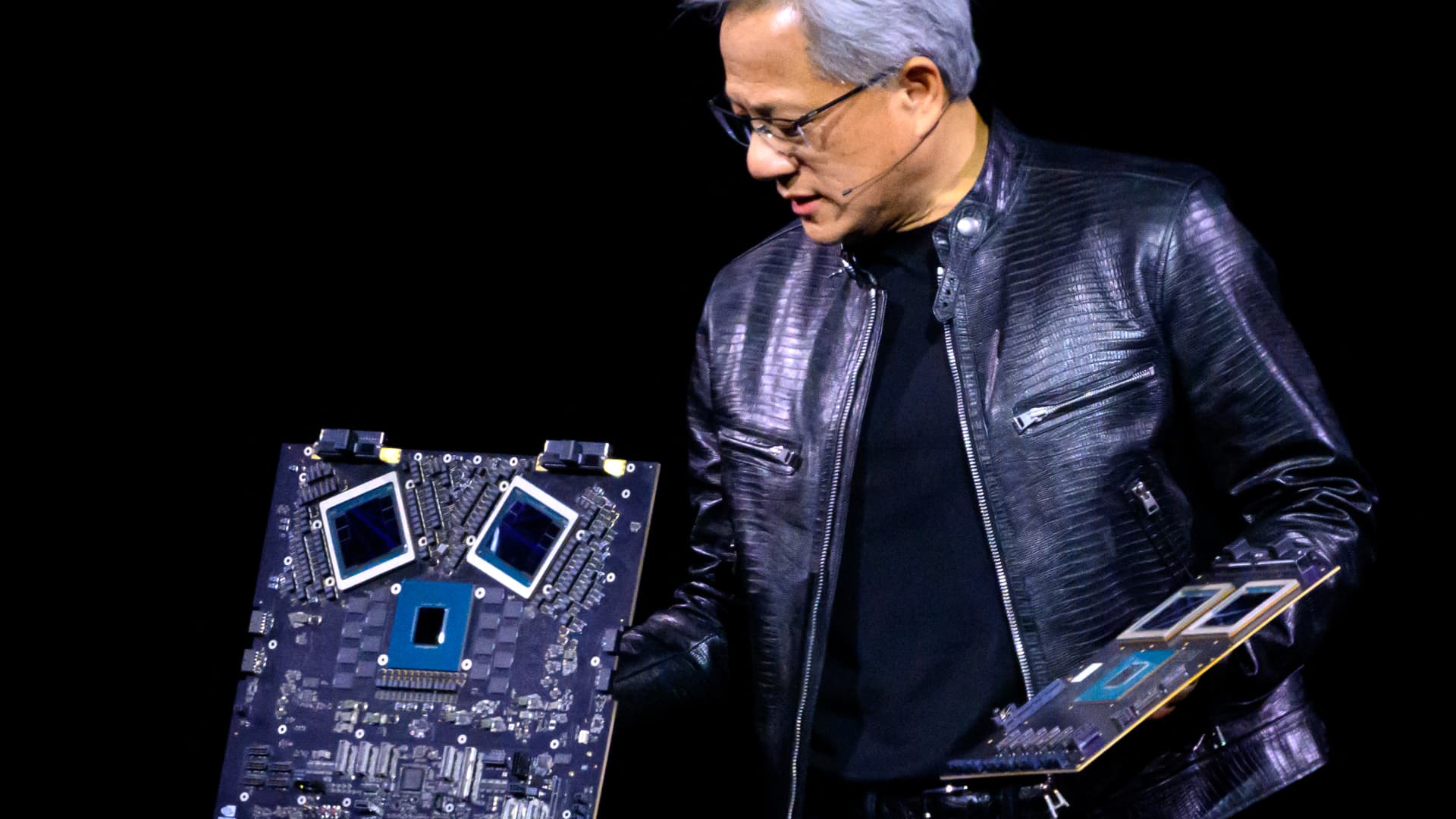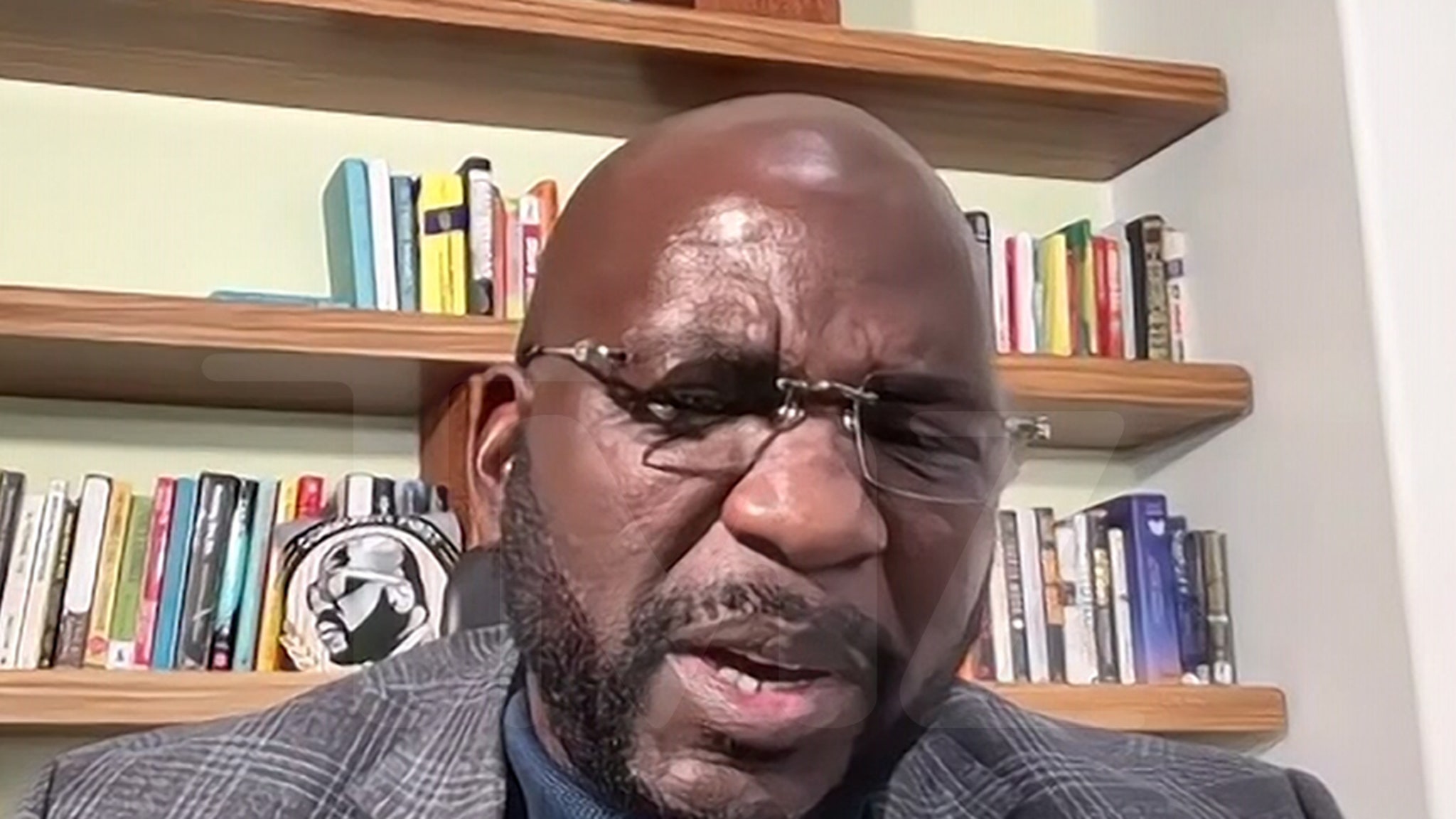Dr. Joshua Bederson places Precision Neuroscience’s electrodes onto a brain.
Ashley Capoot
As the lights dimmed in an operating room at The Mount Sinai Hospital in New York City, Dr. Joshua Bederson prepared to make history.
Bederson, system chair for the Department of Neurosurgery at Mount Sinai Health System, is no stranger to long hours in an operating room. The former competitive gymnast has completed more than 6,500 procedures in his career, and he said he visualizes the steps for each one as if he’s rehearsing for a routine.  Â
On this particular morning in April, Bederson was readying for a meningioma resection case, which meant he would be removing a benign brain tumor. Bederson said his primary focus is always on caring for the patient, but in some cases, he also gets to help advance science.Â
This procedure was one such case.Â
A small crowd gathered as Bederson took his seat in the operating room, his silhouette aglow from the bright white light shining on the patient in front of him. Health-care workers, scientists and CNBC craned forward â some peering through windows â to watch as Bederson placed four electrode arrays from Precision Neuroscience onto the surface of the patient’s brain for the first time.Â
An electrode is a small sensor that can detect and carry an electrical signal, and an array is a grid of electrodes. Neurosurgeons use electrodes during some procedures to help monitor and avoid important parts of the brain, like areas that control speech and movement.
Precision is a three-year-old startup building a brain-computer interface, or a BCI. A BCI is a system that decodes neural signals and translates them into commands for external technologies. Perhaps the best-known company in the field is Neuralink, which is owned by Tesla and SpaceX CEO Elon Musk.
Other companies like Synchron and Paradromics have also developed BCI systems, though their goals and designs all vary. The first application of Precision’s system will be to help patients with severe paralysis restore functions like speech and movement, according to its website.Â
Stephanie Rider of Precision Neuroscience inspects the company’s microelectrode array
Source: Precision Neuroscience
Precision’s flagship BCI is called the Layer 7 Cortical Interface. It’s a microelectrode array that’s thinner than a human hair, and it resembles a piece of yellow scotch tape. Each array is made up of 1,024 electrodes, and Precision says it can conform to the brain’s surface without damaging any tissue.
When Bederson used four of the company’s arrays during the surgery in April, he set a record for the highest number of electrodes to be placed on the brain in real-time, according to Precision. But perhaps more importantly, the arrays were able to detect signals from the patient’s individual fingers, which is a far greater amount of detail than standard electrodes are able to capture.
Using Precision’s electrode array is like turning a pixilated, low-resolution image into a 4K image, said Ignacio Saez, an associate professor of neuroscience, neurosurgery and neurology at the Icahn School of Medicine at Mount Sinai. Saez and his team oversee Precision’s work with Mount Sinai.
“Instead of having 10 electrodes, you’re giving me 1,000 electrodes,” Saez told CNBC in an interview. “The depth and the resolution and the detail that you’re going to get are completely different, even though they somehow reflect the same underlying neurological activity.”
Bederson said accessing this level of detail could help doctors be more delicate with their surgeries and other interventions in the future. For Precision, the ability to record and decode signals from individual fingers will be crucial as the company works to eventually help patients restore fine motor control.Â
The data marks a milestone for Precision, but there’s a long road ahead before it achieves some of its loftier goals. The company is still working toward approval from the U.S. Food and Drug Administration, and it has yet to implant a patient with a more permanent version of its technology.Â
“I think these are little baby steps towards the ultimate goal of brain-computer interface,” Bederson told CNBC in an interview.
Inside the operating room
Dr. Joshua Bederson prepares for surgery at The Mount Sinai Hospital.
Ashley Capoot
Bederson’s surgery in April was not Precision’s first rodeo. In fact, it marked the 14th time that the company has placed its array on a human patient’s brain.Â
Precision has been partnering with academic medical centers and health systems to perform a series of first-in-human clinical studies. The goal of each study varies, and the company announced its collaboration with Mount Sinai in March.Â
At Mount Sinai, Precision is exploring different applications for its array in clinical settings, like how it can be used to help monitor the brain during surgery. In these procedures, surgeons like Bederson temporarily place Precision’s array onto patients who are already undergoing brain surgery for a medical reason.Â
Patients give their consent to participate beforehand.Â
It’s routine for neurosurgeons to map brain signals with electrodes during these types of procedures. Bederson said the current accepted practice is to use anywhere between four to almost 100 electrodes â a far cry from the 4,096 electrodes he was preparing to test.Â
Electrode arrays from Precision Neuroscience displayed on a table.
Ashley Capoot
Precision’s arrays are in use for a short portion of these surgeries, so CNBC joined the operating room in April once the procedure was already underway.Â
The patient, who asked to remain anonymous, was asleep. Bederson’s team had already removed part of their skull, which left an opening about the size of a credit card. Four of Precision’s arrays were carefully laid out on a table nearby.
Once the patient was stabilized, Precision’s employees trickled into the operating room. They helped affix the arrays in an arc around the opening on the patient’s head, and connected bundles of long blue wires at the other end to a cart full of equipment and monitors.
Dr. Benjamin Rapoport, Precision’s co-founder and chief scientific officer, quietly looked on. Every major procedure presents some risks, but the soft-spoken neurosurgeonâs calm demeanor never wavered. He told CNBC that each new case is just as exciting as the last, especially since the company is still learning.Â
Experts help set up the wiring for Precision Neuroscience’s technology.
Ashley Capoot
Bederson entered the operating room as Precision’s preparations neared their end. He helped make some final tweaks to the set up, and the overhead lights in the operating room were turned off.Â
Ongoing chatter quieted to hushed whispers. Bederson was ready to get started.Â
He began by carefully pulling back a fibrous membrane called the dura to reveal the surface of the brain. He laid a standard strip of electrodes onto the tissue for a few minutes, and then it was time to test Precision’s technology.Â
Using a pair of yellow tweezers called long bayonet forceps, Bederson began placing all four of Precision’s electrode arrays onto the patient’s brain. He positioned the first two arrays with ease, but the last two proved slightly more challenging.Â
Bederson was working with a small section of brain tissue, which meant the arrays needed to be angled just right to lay flat. For reference, imagine arranging the ends of four separate tape measures within a surface area roughly the size of a rubber band. It took a little reconfiguring, but after a couple of minutes, Bederson made it happen.
Real-time renderings of the patient’s brain activity swept across Precision’s monitors in the operating room. All four arrays were working. Â
In an interview after the surgery, Bederson said it was “complicated” and “a little bit awkward” to place all four arrays at once. From a design perspective, he said two arrays with twice as many points of contact, or longer arrays with greater spacing would have been helpful. Â
Bederson compared the arrays to spaghetti, and the description was apt. From where CNBC was watching, it was hard to tell where one stopped and the next began. Â
Once all the arrays were placed and actively detecting signals, Precision’s Rapoport stood with his team by the monitors to help oversee data collection. He said the research is the product of a true team effort from the company, the health system and the patient, who often doesn’t get to see the benefits of the technology at this stage.Â
“It takes a village to make this sort of thing move forward,” Rapoport said.Â
CNBC left the operating room as Bederson began removing the tumor, but he said the case went well. The patient woke up afterward with some weakness in their foot since the surgery was within that part of the brain, but Bederson said he expected the foot would recover in around three to four weeks.Â
Employees from Precision Neuroscience collecting data.
Ashley Capoot
Rapoport was present at this particular surgery because of his role with Precision, but he’s well acquainted with the operating rooms at Mount Sinai.Â
Rapoport is a practicing surgeon and serves as an assistant professor of neurosurgery at the Icahn School of Medicine at Mount Sinai. Rapoport reports to Bederson, and Bederson said the pair have known one another since Rapoport was in residency at Weill Cornell Medicine.
Dr. Thomas Oxley, the CEO of the competing BCI company Synchron, is also a faculty member under Bederson. Synchron has built a stent-like BCI that can be inserted through a patient’s blood vessels. As of early February, the company had implanted its system into 10 human patients. It is also working toward FDA approval.Â
Bederson has an equity stake in Synchron, but he told CNBC he didn’t realize how much it would prevent him from participating in research with the Synchron team. He has no monetary investment in Precision.Â
“I really did not want to have any financial interest in Precision because I think it has an equally promising future and wanted to advance the science as fast as I could,” Bederson said.Â
Rapoport also helped co-found Musk’s Neuralink in 2017, though he departed the company the following year. Neuralink is building a BCI designed to be inserted directly into the brain tissue, and the company recently received approval to implant its second human patient, according to a report from The Wall Street Journal on Monday.Â
As the BCI industry heats up, Bederson said the amount that scientists understand about the brain is poised to “explode” over the next several years. Companies like Precision are just getting started.Â
Dr. Joshua Bederson helps set up Precision Neuroscience’s electrode arrays.
Ashley Capoot
“I really feel like the future is where the excitement is,” Bederson said.
Rapoport said Precision is hoping to receive FDA approval for the wired version of its system “within a few months.” This version, which is what CNBC saw in the operating room, would be for use in a hospital setting or monitored care unit for up to 30 days at a time, he said.Â
Precision’s permanent implant, which will transmit signals wirelessly, will go through a separate approval process with the FDA.Â
Rapoport said Precision hopes to implant “a few dozen” patients with the wired version of its technology by the end of the year. That data collection would give the company a “very high level of confidence” in its ability to decode movement and speech signals in real-time, he said.Â
“Within a few years, we’ll have a much more advanced version of the technology out,” Rapoport said.









